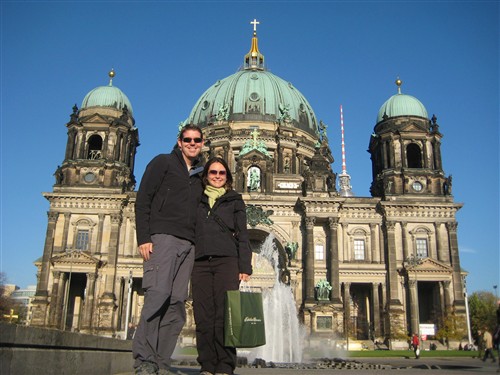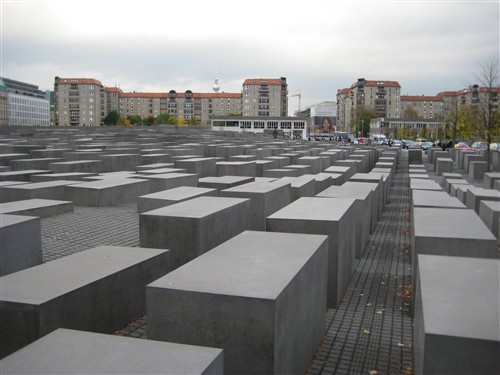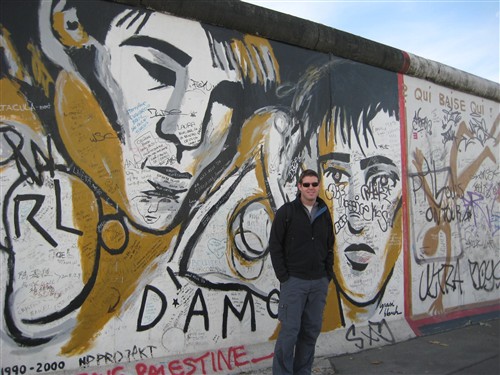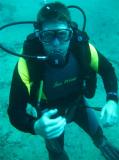Posted under Germany

After an exhausting 10-hour journey on the slow train from Krakow – where we shared a compartment with a single mother, her five wild children, and fifty boisterous teenagers returning from a high school field trip – we arrived at our budget hotel excited but lethargic. There were several tempting restaurants highlighted in our guidebook, but we were unable to summon the energy for a Saturday night out. Instead we wandered down a street around the corner from our hotel and stumbled upon a little Italian restaurant with candlelit tables. Steaming plates of pasta and the carafe of Chianti were exactly what we needed.
We only had two days in the German capital and we were determined to make them count. Our first day began at the Gemäldegalerie, a spectacular fine art museum showcasing an enormous collection of 13th to 18th century European paintings by many of our favorite artists. The museum was spacious and softly illuminated by natural sunlight, a signature of its purpose-built design. It was opened in the mid-1990s after German reunification when the two states merged collections. The collection of paintings was one of the best that we’ve seen.
We departed after a tasty lunch at the museum café and continued on with a self-guided walking tour of central Berlin. Almost immediately we discovered that I had forgotten to replace the memory card in our camera after my last picture download session. The metro tickets in Germany are quite expensive by European standards and I knew that a trip back to the hotel would cost as much as buying a new memory card. With a self-deprecating determination, I led my wife on a wild goose chase try to buy a new card only to be reminded that, in much of Europe, retail outlets are closed on Sundays. Eventually, Tina put an end to my madness by insisting that we return to the hotel, grab the card, and get on with our day.
 Reloaded, we began at Potsdamer Platz, an area once divided by the Wall and abandoned after WWII; it’s now a model of urban renewal. We strolled along the sidewalks in the shadows of glass-covered skyscrapers and flashy new buildings. The Sunday crowds were out in force, visiting the museums, cinemas, restaurants and bars that now populate the area. Slowly we made our way to Berlin’s Holocaust Memorial, an urban area covered with 2,711 gray concrete stelae, which bore a striking similarity to a cemetery. It was fascinating and poignant memorial for the victims of one of history’s most heinous crimes.
Reloaded, we began at Potsdamer Platz, an area once divided by the Wall and abandoned after WWII; it’s now a model of urban renewal. We strolled along the sidewalks in the shadows of glass-covered skyscrapers and flashy new buildings. The Sunday crowds were out in force, visiting the museums, cinemas, restaurants and bars that now populate the area. Slowly we made our way to Berlin’s Holocaust Memorial, an urban area covered with 2,711 gray concrete stelae, which bore a striking similarity to a cemetery. It was fascinating and poignant memorial for the victims of one of history’s most heinous crimes.
Our next stop was the Brandenburg Gate, a symbolic dividing line during the Cold War (the Berlin Wall famously curved around the square) and now one of the most popular spots for a photo op. We maneuvered through the crowd to snap our photos and then moved on to the hulking, yet beautiful Reichstag, now home to the German parliament. Thoroughly enjoying the crisp fall air we continued along the Spree River, down Unter den Linden and Friedrichstrasse – two of Berlin’s main shopping thoroughfares.
 We finally arrived at Checkpoint Charlie, the main gateway through the Berlin Wall for Allies and diplomats between East and West Germany during their tumultuous thirty year separation. Today the “checkpoint” is nothing more than a reconstructed guardhouse, a couple of replica signs, and the requisite tourist shops, but from 1961 to 1989, Checkpoint Charlie was the symbolic centerpiece of the Cold War. A nearby row of billboards provided us with a synopsis of the major events in the global struggle between Communism and Capitalism and the important role played by the two Berlins separated by the Wall. It was an enlightening exhibit and the perfect precursor to our Russian visit.
We finally arrived at Checkpoint Charlie, the main gateway through the Berlin Wall for Allies and diplomats between East and West Germany during their tumultuous thirty year separation. Today the “checkpoint” is nothing more than a reconstructed guardhouse, a couple of replica signs, and the requisite tourist shops, but from 1961 to 1989, Checkpoint Charlie was the symbolic centerpiece of the Cold War. A nearby row of billboards provided us with a synopsis of the major events in the global struggle between Communism and Capitalism and the important role played by the two Berlins separated by the Wall. It was an enlightening exhibit and the perfect precursor to our Russian visit.
As the day turned to night we leisurely walked to the Gendarmenmarkt, a former marketplace which now attracts hundreds of tourists each night to see the colorfully illuminated buildings that embrace the square. Bordered on either side by domed churches and showcasing the Konzerthaus – home to Berlin’s Symphony Orchestra – the plaza was alive with street musicians, tourists and amateur photographers angling for the perfect shot.
Our next day began with a visit to the longest, best-preserved stretch of the Wall. In fact, the word wall is not quite correct. The Berlin Wall was actually a wide corridor between two walls, which cut Berlin into two halves. One wall marked the actual border on the west side of the corridor, while a second wall closed off the corridor to the east. The death strip, which included a narrow sentry path for the border guards, lay in between. The remaining one-kilometer west side section is now a unique open-air gallery – once a decaying, gray pitted eyesore, most surfaces are now covered with colorful murals, political slogans, and illegible graffiti. We followed the entire length of the wall, frequently stopping to read the emotionally-charged commentary and photographing the most interesting sections.

We spent the next several hours frequenting Berlin’s more modern monuments – the shopping malls. Having followed the warm weather around the world, we were afraid of arriving in Russia at the beginning of winter completely unprepared. After stocking up on hats, mittens, and sweaters, we treated ourselves to big scoops of gelato and a short visit to the neo-Renaissance Berliner Dom – a grand church where most of the German royals are interred.
Our time in Berlin was short and sweet. We saw enough of the city to know that our two-day tour only scratched the surface of this dynamic, cosmopolitan city. But I think we’ll be back. Right now we’ve got other things to think about. Bring on the Russkie!
One Response to “Berlin”

Ed Maroon on 03 Nov 2008 at 8:23 am #
Hey Guys,
I was in Berlin about a month ago and I did the city buss tour. I found myself getting depressed as I saw all of the war monuments. To think of all of the destruction that came out of there. It was also very erie to walk by a bit of the wall. All of those poor people that were killed trying to get to the other side. Although I have not been to anywhere near as many cities as you both, Berlin is last on my list of cities to visit again. On the other hand, Barcelona was outstanding. What a beatufil place. The people all looked like they stepped out of a fashion magazine.
Talk to you soon,
Ed